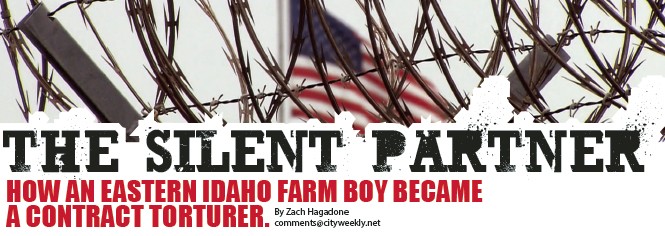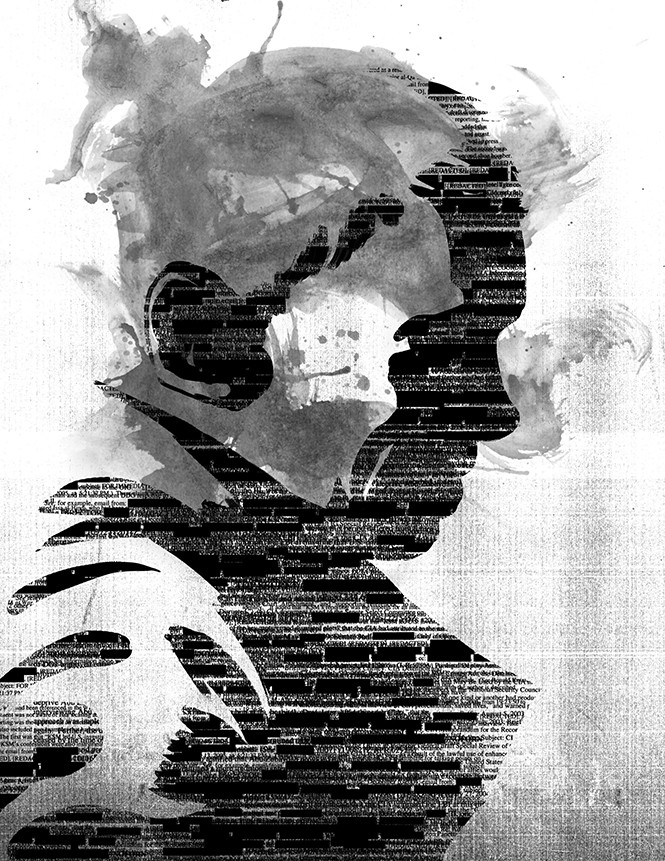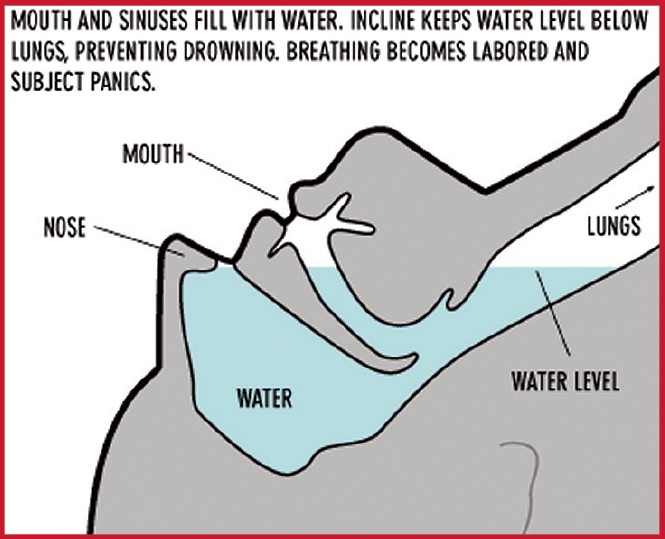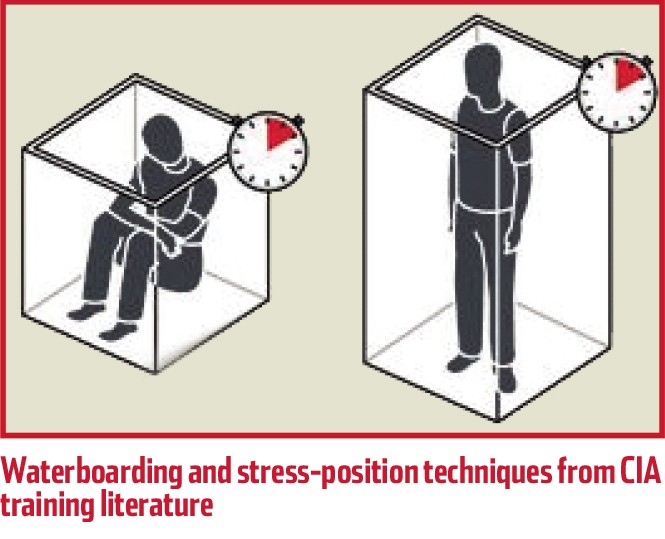Bruce Jessen has been called a war criminal. A torturer. An "American Mengele." The retired Air Force colonel and trained psychologist was, according to a 2014 report from the U.S. Senate Select Committee on Intelligence, an architect of the "brutal," "inherently unsustainable" and "deeply flawed" detainee- interrogation program that "damaged the United States' standing in the world" in the years following the attacks of Sept. 11, 2001.
His alleged actions involved helping design—and in many cases personally administer—methods of interrogation that groups ranging from the American Civil Liberties Union to Amnesty International and the United Nations have labeled as torture.
Those methods, according to the report, were applied in secret throughout the Central Intelligence Agency's now infamous network of "black sites" where detainees were held without charges in "dungeon"-like conditions.
Jessen did not act alone. Fellow retired Air Force officer and psychologist James Mitchell helped design, advise, apply and assess the program—operating in a system with almost no checks and which the CIA's own attorneys admitted would require a "novel" legal defense "to avoid prosecution of U.S. officials who tortured to obtain information."
While Mitchell has publicly pushed back against the report, calling it "bullshit" in a December 2014 interview with ABC News, Jessen has avoided speaking to the media—the silent partner in a global scandal.
The contents of the almost 600 pages of the Senate report are as harrowing as they are detailed, except when it comes to the backgrounds of Jessen and Mitchell, referred to by the pseudonyms of Drs. Dunbar and Swigert, respectively.
Their true names weren't known until a 2007 Vanity Fair report, which presaged much of what would come to light in the 2014 Senate report. Eight years later, as HBO has optioned the rights for an original film based on the article, "Rorschach and Awe," Mitchell is less mysterious but Jessen remains an enigma.
His road to the secret prisons of Afghanistan, Thailand and Poland, however, began in eastern Idaho—literally, on Highway 20, in a small town at the foot of the Teton Mountains.
'Not Much of a Talker'
As Highway 20 runs north from Idaho Falls, the suburbs give way to run-down trackside buildings. Trash-strewn ditches and fields of cattle are interrupted by lonely monochromatic housing developments. Billboards alternately advertise Internet service and professional-technical degrees, and protest against wind power and same-sex marriage.
The road narrows north of St. Anthony, with the Henry's Fork of the Snake River running to the west and the Tetons rising hazy-blue on the eastern horizon. A few miles farther, at the gateway to the Caribou-Targhee National Forest and West Yellowstone, Mont., is the town of Ashton—set in a wide, flat valley punctuated by a cluster of grain silos.
Main Street in Ashton is a collection of mom & pop shops—an auto-parts store, hardware store, liquor store, senior-recreation center, two bars and three churches. Trucks rumble by almost constantly, carrying grain and seed potatoes to the silos that dominate the west side of town. Glance down the side streets from Main and the residential neighborhoods quickly give way to fields.
Springtime is blustery and cold, and potatoes are more plentiful than people.
"It's time to plant the silly things again," said Barbara Moon, who works part-time as Ashton's town archivist. "It used to take the whole town [to plant and harvest], but not anymore."
The Jessens were a potato family. Jessen's father, Jack, worked their land south of town.
"He was a wonderful man, but not much of a talker," Moon said. It was Nieca, Jessen's mother, who was the family's social link.
"She loved people, loved talking to them," Moon said.
Bruce, meanwhile, was quiet, like his father.
"To say I know him—no, I really didn't," Moon said, navigating the stacks of yearbooks, family histories and mountains of newspaper clippings in the small archive office located in the Ashton Chamber of Commerce building.
"I went to a party once [at the Jessen farm] and talked with him and his wife and met his children, but that was it," she said.
Asked if she had heard of the Senate report or read any coverage of its revelations about Jessen's work with the CIA, she said she had not.
"I didn't even know about that," Moon said, though added that she was aware Jessen worked for the government in some capacity in Spokane, Wash.
Moon has lived in Ashton for 50 years—long enough to know just about everyone in town but, because she wasn't born there, she gets teased occasionally that she's not a native.
"Like all small towns, it has its good sides and its bad sides, but it's a wonderful place to raise a family," she said.
Jessen's family goes back a long way in the Ashton area. His mother was born in nearby Marysville to the Cordingley family, whose members to this day are "everywhere," Moon said.
"You have to be careful what you say around here, because everybody knows everybody," she said.
Of Jessen, Moon could only repeat that she didn't know him well, though she did add that one of his two sisters is among her best friends.
"What little I knew of him, I thought he was nice," Moon said. "And quiet is right. Very intelligent."
According to Moon, the Jessens were a tight-knit family, and Bruce was especially close with his adopted brother, who recently passed away. The Jessens took in the boy when he was about 8 years old. He and Bruce were close in age, graduating from high school in the same class.
Inviting another child into her family was in line with Nieca's personality, Moon said.
"Nieca was that kind of person," she said, adding that each spring the matriarch would host a party for the senior high-school girls "just because she wanted to." Another yearly party would be thrown for Sunday school teenagers.
"Everybody in the town was there," Moon said. "Everybody loved her in town."
For Bruce, active in high-school sports, intelligent and good-looking, Ashton probably started to feel too small.
"He had to work; dig potatoes and plow—I know he did that," Moon said. "No wonder he wanted to go do something else."
'Something Not Previously Seen'
In August 2002, Jessen was a long way from Ashton. By that time, he and Mitchell had secured a contract with the CIA that would come to be worth upward of $180 million by 2006. Their job was to travel through the agency's prison system to help coordinate the application of "enhanced interrogation techniques" that they developed based on their work as former training experts in the SERE program—short for Survive, Evade, Resist, Escape. Intended to train U.S. military personnel how to withstand harsh interrogation at the hands of unscrupulous enemies, Jessen and Mitchell had reportedly "reverse-engineered" the techniques to craft what has been referred to as the U.S. "torture program."
At a CIA black site in 2002, which was later reported to be located in northeast Poland, Jessen and Mitchell were preparing for the biggest test of their methods yet. Abu Zubaydah had been captured in Pakistan in March 2002 and was being held on suspicion of running an al Qaeda site there. When enhanced techniques—including the now well-known practice of simulated drowning called waterboarding—were approved for use on Zubaydah, only Jessen and Mitchell were to have contact with him.
Based on the psychologists' plan, Zubaydah was subjected to enhanced interrogation techniques on a "near 24-hour-per-day basis" for 17 straight days, according to the Senate report. He was shackled, hooded and stripped on the first day of interrogations, as an interrogator slammed him against a wall. He was unhooded and made to watch as interrogators brought in a large "confinement box" that was placed in his cell to mimic a coffin. If Zubaydah did not offer the asked-for information, he was slapped or grabbed by the face.
He maintained that he did not have any additional information, and Jessen and Mitchell were not authorized by CIA leadership to ask any questions other than to demand Zubaydah's knowledge of plans to attack the United States.
The enhanced techniques were continued, with Zubaydah being waterboarded two to four times per day for more than two weeks in what the report called the "aggressive phase of interrogation." During a total of 20 days, Zubaydah spent 11 days in the coffin-size confinement box and 29 hours in a smaller box, which measured 21 inches wide, 2.5 feet deep and 2.5 feet high. According to the report, Zubaydah was told that the only way he would leave the facility was in the coffin-shaped box.
When concerns reached CIA Headquarters that the interrogation was "approach[ing] the legal limit," Counterterrorism Center Chief Jose Rodriguez responded by telling CIA officers not to question the legality of their activities in written communications. "Such language is not helpful," he wrote.
According to the Senate report, several members of the agency exposed to—or involved in—the tactics expressed "reservations about being engaged in the interrogations."
Emails excerpted in the report, dated August 2002, show a deep unease about viewing the interrogations—both in person and on video:
"It is visually and psychologically very uncomfortable."
"It seems the collective opinion that we should not go much further."
"Several on the team [were] profoundly affected ... some to the point of tears and choking up."
"[Video footage] has produced strong feelings of futility (and legality) of escalating or even maintaining the pressure. ... Prepare for something not previously seen."
Reporting from the detention sites became sparse—enough so that the CIA general counsel was concerned that, without more frequent and detailed reports, "the agency cannot monitor the situation."
The situation was, according to some, running off the rails.
According to the report, at least five detainees were subjected to having liquids—whether water or pureed food—injected into their rectums, including Zubaydah. At least once he was also the subject of an "unexpected rectal exam" as part of the detention site's security protocols.
At the end of his August 2002 interrogation, Zubaydah was found to have been telling the truth that he had no new threat information. Meanwhile, he had lost an eye at some point during his detention and several video recordings of his interrogation were destroyed. He was waterboarded 83 times.
Despite the CIA's belief that he was the "third or fourth" highest ranking al Qaeda, Zubaydah turned out to be a low-level administrator. What little information he provided came in the two months before Jessen and Mitchell arrived with their techniques. Zubaydah is currently imprisoned in Guantanamo Bay, Cuba—a prisoner held without charges for more than 12 years.
Jessen and Mitchell wrote in a cable that the interrogation was a success, with the "aggressive phase" of the questioning recommended as a "template for future interrogation of high value captives." Their reasoning was not that the tactics produced useful information, but that they confirmed what Zubaydah didn't know.
"Our goal was to reach the stage where we have broken any will or ability of subject to resist or deny providing us information (intelligence) to which we had access," Jessen and Mitchell wrote. "We additionally sought to bring subject to the point that we confidently assess that he does not/not [sic] possess undisclosed threat information, or intelligence that could prevent a terrorist event."
'It is No Wonder They Settled Here'
In mid-April, snow still lay in the playground next door to the Zion Lutheran Church in Ashton. Across the street is the Ashton Library, which, along with North Fremont High School and the Church of Jesus Christ of Latter-day Saints ward house a few hundred yards down Main Street, is the nicest building in town.
Among the volumes of local history is a two-volume collection titled Ashton Family Histories, 1906-2006, and a stack of North Fremont High School yearbooks. Between those sources, a basic picture of the Jessen family begins to take shape.
The Jessens take up 11 pages in Ashton Family Histories, not counting extended relations. When asked about the family, the librarians were quick to name several members, including Jessen's sisters. When the subject of Bruce Jessen came up, they, like Moon, said they didn't know him well.
John "Bruce" Jessen was born July 28, 1949, in St. Anthony, Idaho, the youngest of three children in the family of John "Jack" Jessen and Nieca Cordingley Jessen. He grew up in Ashton, where, according to an entry in Family Histories, his family could trace a "history of early settlement" and count "six generations of childhood."
Aside from working as a farmer, father Jack was a member of the volunteer fire department and served on the Potato Board. Nieca worked at a variety store in Ashton, was assistant manager of an irrigation company, served as president of the local LDS relief society and taught Sunday school. She volunteered with the Ashton Chamber of Commerce and served a term as its president. Both Jack and Nieca served in the Idaho Falls LDS Temple for 23 years.
Jessen spent his childhood on a century-plus-year-old homestead that the family bought 2 1/2 miles southwest of Ashton on Highway 20.
Affectionately called "the farm" by family and friends alike, the Jessens raised their children in an idyllic rural setting. Photos in Ashton Family Histories show a rolling lawn and orchards.
Nieca described her home as "this beautiful little valley in Ashton, Idaho. To the East lies the majestic Teton Mountains. To the North the Snake River, and the beautiful forest with pines, aspen and mountain ash trees. To the West, the rolling sand hills, and the South, on to the big city. It is no wonder they settled here in this little valley in the 1800s."
In the 1980s, the Jessens sold the farm and turned it into an R.V. park and bed & breakfast, which became a family gathering place and stopping point for tourists on their way to Yellowstone and the ski resorts of western Wyoming. Nieca ran the park until her death in 2013, and it is now operated under a new name by new owners, though a roadside sign still bears the name "Jessen's R.V. Park."
Jessen graduated from North Fremont High School in 1967, where he was involved in a range of activities, including ski club, band, assemblies, Boys State, baseball, football, basketball, track and wrestling.
Photographs in his senior yearbook show a handsome, athletic kid.
After high school Jessen attended then-Ricks College, now Brigham Young University-Idaho, a few miles down the road from Ashton in Rexburg, going on to graduate cum laude from Utah State University in 1974, where he majored in psychology with a minor in aerospace studies and Italian. He went on to earn his doctorate in psychology, with an emphasis in professional-scientific psychology, from USU in 1979.
During that time he was enlisted in the Air Force and completed an internship in clinical psychology at Wilford Hall Medical Center in San Antonio, Texas.
Jessen's doctoral thesis was titled "The Effect of Family Sculpting on Perceptual Agreement Among Family Members" and focused on a technique for family therapy.
Of the six USU faculty members who advised Jessen on his dissertation, only two are still living. Asked if she remembered Jessen as a student, Dr. Jean Pugmire, who still lives in Logan, Utah, said, "No, I really don't."
"I think you'll find that most of the people that would have been involved with him are dead," she said. "I'm sorry, but I don't remember him at all."
More by Zach Hagadone
-
The Silent Partner
How an eastern Idaho farm boy became a contract torturer
- Jun 17, 2015
- More »
Latest in Cover Story
Readers also liked…
-
Forget the family pedigree—Robert F. Kennedy Jr should not be the next president of the United States
Trojan Horse
- Jun 21, 2023
-
Women decry harassment and toxic culture at St. George auto dealership
Men at Work
- Oct 11, 2023











